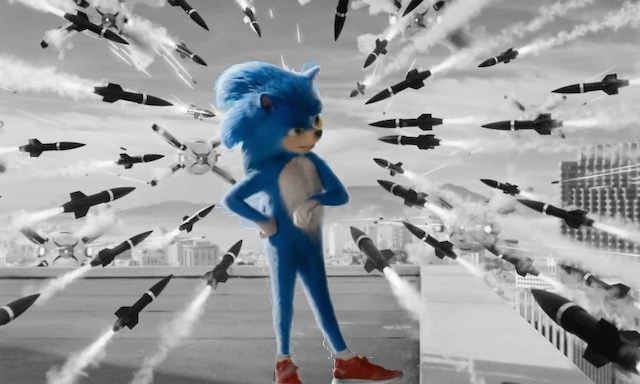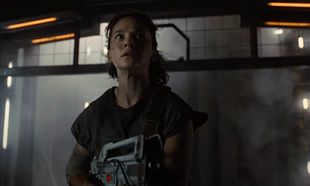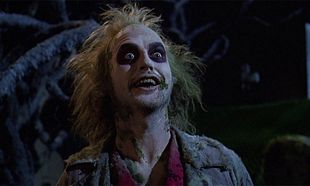In case you're not following movie / entertainment news over the past couple of days, here's a quick primer on the 'Sonic' debacle.
The very first trailer for the long-awaited and ill-advised live-action 'Sonic The Hedgehog' lands online. In it, we see a 'Sonic' that has girthy legs, flat and lifeless eyes, and a head full of human teeth. To say it left a residue of psychic trauma in humanity's collective consciousness is an understatement.
People tore their clothes off, heaped the earth upon their heads, the moon turned to blood red and seas began to bubble and rise. It was bad. Really, really bad. In the space of a day or two, fan-submitted designs began to circulate which looked far more in keeping with the general idea of what Sonic looked like.
After all, you have to remember that Sonic began life in a 16-bit, 2D environment so transposing that to a photo-real environment was always going to be an uphill struggle. Still, these new designs were warmly received by a public traumatised by a head full of human teeth inside Sonic's bespiked features.
On the fourth day of 'Sonic'-gate comes director Jeff Fowler, speaking in calming tones to a perturbed internet that, yes, these designs can be changed and they will be changed. We can all, it seems, rest easy knowing that on November 8th, we will not be confronted with the abomination of thick legs and bright-blue fur on cinema screens. However those changes will look, we don't know.
Thank you for the support. And the criticism. The message is loud and clear... you aren't happy with the design & you want changes. It's going to happen. Everyone at Paramount & Sega are fully committed to making this character the BEST he can be... #sonicmovie #gottafixfast 🔧✌️
— Jeff Fowler (@fowltown) May 2, 2019
You're probably thinking to yourself, "Hey, you said this was a bad idea," and no, this shouldn't be one. After all, the design was horrific, it gave people nightmares, it looked cheap and crap - so why is it changing it a bad thing?
Two words - VFX artists.
Looking at that trailer, you could guess that a significant amount of the movie has been shot and that the VFX - so far, anyway - is in its final stages. Normally, with movies that have this many VFX shots, the finalised versions are the ones given to trailer editors for inclusion. In other words, everything you saw on that trailer was the finished version of that scene.
Given how this is a movie that features a blue, talking hedgehog with anthropomorphic features, we can assume there's a butt-load of VFX shots in this movie - far more than what we saw.
The average VFX pipeline - that's the process that takes it from a design's brain to a reality on screen - includes 11 stages. That's according to CG Spectrum, a college of digital art and animation in Australia. It begins with storyboarding and animatics, pre-vis, concept art and design, layout and production design, and then on to research and development before it reaches 3D modelling and texturing. From there, it's rigging and animating, FX and simulation, before it ends with lighting, rendering and compositing.
There are no examples of how long a VFX pipeline typically is, because the truth is that they very so wildly depending on budget, availability, level of work and skill involved, and a myriad of other factors.
All of this, by the way, is carried out by people earning an average of around €45,000 - €55,000 per year, often with almost no job security and in an environment where they're putting in 10+ hour days. When it comes closer to deadlines, those hours can easily go up to 15. Some people even bring sleeping bags into the office.
In the industry, this is commonly known as 'crunch'. In 2018, GameInformer wrote a damning article on the realities of artists in the games industry who regularly dealt with 'crunch' when it came to meeting shipping deadlines on games. The article details how the majority of US-based developers do not pay overtime for 'crunch', and very often expects artists to accept it as a given in their work.
Obviously, not all VFX artists in the movie industry work along these lines, but there are a few examples of how bad it is. In 2016, the Seth Rogen-starring animated comedy 'Sausage Party' was the subject of serious complaints by animators who worked on the project. A Washington Post article described how animators were allegedly pressured, left uncredited for their work, threatened with blacklisting, and ordered to do unpaid overtime. Nitrogen Studios, the company behind the VFX work on 'Sausage Party', denied all of this.
It goes without saying that we must assume and hope that the VFX company hired to work on 'Sonic The Hedgehog' is paying their staff for overtime, that there is a clear and mandated procedure for paying and crediting for extra work, and that none of the disturbing practices that appear so prevalent in the industry are being carried out in this production.
If the original design of 'Sonic' wasn't up to scratch, the blame starts at the top - not in the VFX artists who worked on what was signed off on. Now that redesigns have been ordered, they're the ones that have to make it happen.
They're the ones that, to paraphrase the blue hedgehog, have to work fast to meet the release date.











































































